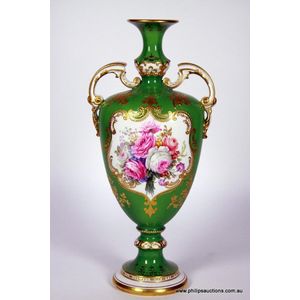Spode Campana Vase with Gilded Birds and Roses
You must be a subscriber, and be logged in to view price and dealer details.
Subscribe Now to view actual auction price for this item
When you subscribe, you have the option of setting the currency in which to display prices to $Au, $US, $NZ or Stg.
- Frieze - An architectural term denoting the flat, shaped or convex horizontal surface of furniture, between the architrave and the cornice, usually found on a cabinet or bookcase, or on desks and tables where it may include drawers, the area between the top and the legs. In ceramics, the term refers to the banding, of usually a repeating pattern, on the rims of plates and vases.
- Gilding - Gilding is a method of ornamentation whereby a thin sheet of gold metal is applied to items made of wood, leather, ceramics, glass and silver for decorative purposes.
For furniture including mirrors, the sheet of gold is usually applied over a coating of gesso. Gesso is a mixture of plaster of Paris and gypsum mixed with water and then applied to the carved wooden frames of mirrors and picture frames as a base for applying the gold leaf. After numerous coats of gesso have been applied, allowed to dry and then sanded a coat of "bole", a usually red coloured mixture of clay and glue is brushed on and allowed to dry, after which the gold leaf is applied. Over time parts of the gilding will rub off so the base colour can be seen. In water gilding, this was generally a blue colour, while in oil gilding, the under layer was often yellow. In Victorian times, gilders frequently used red as a pigment beneath the gold leaf.
Metal was often gilded by a process known as fire gilding. Gold mixed with mercury was applied and heated, causing the mercury to evaporate, the long-term effect of which was to kill or disable the craftsman or woman from mercury poisoning. The pursuit of beauty has claimed many victims, not the least of which were the artists who made those pieces so highly sought after today. - Circa - A Latin term meaning 'about', often used in the antique trade to give an approximate date for the piece, usually considered to be five years on either side of the circa year. Thus, circa 1900 means the piece was made about 1900, probably between 1895 and 1905. The expression is sometimes abbreviated to c.1900.
- Campana Form Vases or Urns - A campana form vase or urn is a type of ceramic or metal container that is characterized by its reverse bell-like shape. The shape is typically wider at the top and narrower at the bottom, with a curved or flared opening at the top. The vase or urn may have a handle or handles on either side of the opening.The campana form was popular in ancient Greece and Rome, and the design has been revived in various forms throughout the history of art, including the Renaissance and the Art Nouveau period.
This item has been included into following indexes:
Visually similar items

A Coalport urn vase, circa 1810, probably London decorated, a green marbled urn with sea creature scroll handles, well decorated to a reserve with a profuse loose bunch of summer flowers arranged in a basket; unmarked, illustrated in Godden's 'Coalport...'

A Paris Porcelain urn, 20th century, the trumpet form campana urn with a gadroon rim, rams' head bracket handles and raised upon a spreading socle to a squared base, decorated to shaped reserves with baskets of flowers in coloured enamels upon an apple gre

A Spode campana vase, decoration attributed to Thomas steel, circa 1820, the pedestal vase with a pair of small looped handles with lion's head mounts, lavishly decorated with vegetal borders, anthemion and seaweed motifs in gold upon a white ground, a pai

A green Royal Bonn vase, late 19th century, the cushion profile tear drop vase with a trumpet neck, scrolling moulded high set handles and raised on shaped pedestal base, decorated with a loose bunch of full blown roses within a gilt paste cartouche upon a
